Thursday 28 October 2010
Soemmerring's Gazelle - Once the Most Abundant Gazelle, Now Nearing Endangered Status
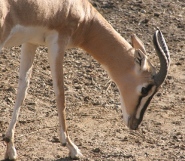
The
Soemmerring's Gazelle (
Gazella soemmerringii) were once the most abundant Gazelle on the African continent, moving about in large herds of several hundred. Today, they can be found in small groups between 5 and 20, often intermingling with herds of hartebeest, oryx, and domesticated camels. Both CITES and IUCN have listed the Soemmerring's Gazelle as a vulnerable species due to a 30% decline over 3 generations (21 years). Current estimates are that the decline will continue at a rate of about 10% per year. The likeliest cause of the decline is the loss of habitat to domestic grazing, hunting, and regional political unrest.
Soemmerring's Gazelle have a tawny brown coat interrupted by patches of white around the head, covering the belly, inside the legs, and over the rear end. Three black stripes extend from the top of the skull to the nose, with one covering each eye and the other centered on the bridge of the nose. The horns grow back over the skull in a lyre shape, are ridged, and can grow up to 22 inches (58 cm) long. Adults can measure 4-5 feet (120-150 cm) in length, 2.3-3 feet (85-92 cm) high at the shoulders, and weigh from 70-100 pounds (35-45 kg).
The Soemmerring's Gazelle inhabit lightly forested steppes and savannas on the Horn of Africa, from Eastern Sudan through Ethiopia, Eritrea, Djibouti, and Somalia. Food sources include acacia, brush leaves, grass, and herbs, and are known to migrate with the rainy season to ensure sufficient food is available. As a large herbivore they are food sources for several large predators, including the cheetah,
lion, leopard, hyena, Cape hunting dog, and python. The primary defensive measure against predators is the ability to run and leap through the air for considerable distance at high speeds, up to 50 mph (80 kph).
Although the horns can be used for defense as well, most of the wear and tear visible on the horns of older males is from territorial disputes with other males. During the period from September to November males will mate with receptive females while walking together, with the male continuing to walk after mounting with his two hind legs. Gestation is 199 days, or about 6-1/2 months, so that the birth of a single infant occurs during the rainy season when food and water is plentiful. The young are weaned after 6 months, reach sexual maturity in 1.5 years, and live for up to 14 years.
Picture of the Soemmerring's Gazelle by , licensed under
GFDL
You can help spreading the word about this animal by liking it on facebook
Permanent Link
Tuesday 26 October 2010
Lyle's Flying Fox - Buddhist Refugees
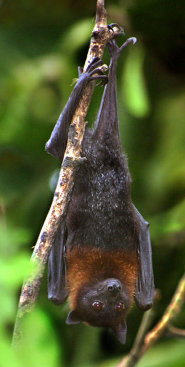 Lyle%u2019s Flying Fox
Lyle%u2019s Flying Fox (
Pteropus lylei) belongs to the large family of mammalian old world fruit bats or flying foxes. The Spanish name is Zorro Valador De Lyle. As the common name suggests fruit bats live on nectar, pollen, blossoms, and fruit, and for this reason their habitats are limited to tropical and subtropical regions of the world. Old world fruit bats are the largest bats in the world, with wing spans up to 6 feet (1.8 meters) and weighing as much as 2.2 pounds (1.5 kg). By comparison, the size of Lyle’s flying foxes is about mid-sized within the fruit bat family.
Lyle’s flying foxes will colonize trees in large groups, where they nest and suckle their young during the day. At night they depart to forage for food and have been known to travel 40 miles away to find food. Rather than using echolocation as their insectivore cousins do, fruit bats rely on well-developed visual and olfactory senses.
The habitat of Lyle’s flying foxes is limited to Thailand, Cambodia, Viet Nam, and the Yunnan Province of China. Even though little is known about populations within China, Lyle’s flying foxes have been listed by IUCN as vulnerable or one step away from being considered endangered. Until recent hunting restrictions were put into place, fruit bats were considered a delicacy and were hunted legally. Hunting still occurs in some places, but habitat degradation and destruction has also contributed to the 30% population decline over the past 15 years (three generations). In Thailand and Cambodia, Lyle’s flying foxes are considered pests and are not protected except on temple grounds. For this reason, large, noisy colonies of Lyle’s flying foxes can be found colonizing the trees over some Buddhist temples in Cambodia and Thailand. Up to 11 colonies are known to exist in Thailand and the largest contains close to 3000 individuals.
The size of fruit bats can be truly startling when first encountered at night by strangers to tropical climes and has resulted in reports of vampire bats or flying pterodactyls, but unless you’re a fruit or flower, or smell like one, you have little to fear. Okay, a little fear is appropriate. Over the past 10 years or so several research studies have found that fruit bats, including Lyle’s flying foxes, are hosts for emerging viruses that can infect and kill livestock and
humans.
Picture of the Lyle's flying fox by Malene Thyssen, licensed under
GFDL
You can help spreading the word about this animal by liking it on facebook
Permanent Link
Monday 25 October 2010
Carp Bream - European Bottom-Dwellers
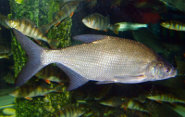
The
carp bream (
Abramis brama) is an abundant fresh-water fish commonly found at the bottoms of fresh-water canals, lakes and ponds, and on some river bottoms. Their silvery gray body is flat with a high back, and gray or black fins. Older fish may have a bronze color, especially if living in clear water. Adult carp bream can range in size from 12" to 22" (30-55 cm), and weigh between 4 and 9 pounds (2-4 kilograms).
The carp bream is an widespread European and Asian species not currently threatened. Their home range is that part of Europe north of the Pyrenees and the Alps, stretching north to the southern reaches of Scandinavia, and east through the Balkans to those areas around the Aral, the Caspian, and the Black Seas.
Carp bream live in schools on the bottoms of lakes and rivers. At night, they feed close to shore, and, during the day, on sandy bottoms in clear water. The carp bream's small protracting mouth digs through mud and silt for larvae, gastropods, and bivalves on which to feed, and nibbles on plankton and water plants. A large carp bream may even eat other small fish. Carp bream themselves are eaten by perch and pike.
Bottom overfeeding may result in food shortages, and the young fish in the school may have to resort to filter feeding with their gill rakers, catching small aquatic crustaceans called water fleas for food. But, as the carp bream reach adulthood, their gill rakers grow far enough apart that they are no longer able to feed on this abundant prey, resulting in a natural limit on the carp bream's size for those that feed mostly on water fleas.
The carp bream sexually mature around the age of three years. Spawning occurs for the carp bream April to June. Males patrol and protect territories where females lay their many eggs upon the leaves and stems of water plants. Over a week or two, the eggs develop into fish larvae, and then into slender young
fish, who detach from the plants, and live as youngsters in the "water column," the vertical length of water stretching from the surface to the bottom. The young carp bream do not become full-fledged bottom-dwellers until they are at least several months old. At that point, they achieve the body and color of the adult carp bream, and begin bottom-feeding.
You can help spreading the word about this animal by liking it on facebook
Permanent Link
Tuesday 19 October 2010
Spiny Mouse: A Fragile Tail
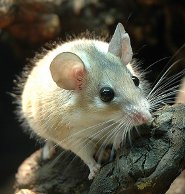
The
Spiny Mouse (
Acomys spinosissimus) is a small mammal, specifically a species of rodent of the Muridae family. It lives alone, or in small groups, inhabiting deserts, rocky terrain or dry woodlands. It is a nocturnal creature, but it does come out in early morning or late afternoon, keeping to the shadows. It is found in northeastern South Africa and the neighboring countries to the north and east: Malawi, Tanzania, Botswana, Mozambique, Zimbabwe, Zambia, and the Democratic Republic of the Congo.
The name
Acomys spinosissimus literally means "sharp-pointed mouse," a reference to the stiff thick hairs that stand out from its back. It has large black eyes and enormous rounded ears, both well-suited for nocturnal activities. Like almost all other mice of the genus Acomys, the spiny mouse has a white or creamy underbelly; unlike most other mice of the genus, its upper body is reddish-gray. On the average, a spiny mouse is 6.7" (17 cm) long, including a tail that, by itself, is about 3" (8 cm) long. The average weight of a spiny mouse is just under one ounce, or about 28 grams.
The spiny mouse's tail is covered with sparse coarse fur, and can break off rather easily. It is thought that this fragility is a defense against predators, who, upon grabbing a spiny mouse by the tail, would then be left with only the tail. Unlike a similar predator defense found in some lizards, the tail of the spiny mouse does not grow back.
The spiny mouse eats seeds, green leaves, snails, insects, and millipedes. Predators who prey on the spiny mouse are the small wild cats, the mongoose, and various
birds of prey native to South Africa, such as owls, eagles, falcons, hawks, harriers, and secretary birds.
The lifespan for a spiny mouse is anywhere from four to seven years. Spiny mice reach sexual maturity about two months after birth. Females can conceive at any time during the year. Once a female spiny mouse is pregnant, she gestates for about forty days before she gives birth. Most litters contain two or two pups, but some litters have been seen with six. Spiny mice are born with their eyes open, leave the nest at the age of three days, and are weaned in a little over a month. A female can conceive and produce up to twelve litters in a year, which is one reason the spiny mouse is not an endangered species.
Picture of the spiny mouse by Marcel Burkhard, licensed under the
Creative Commons Attribution-Share Alike 2.0 Germany license.
You can help spreading the word about this animal by liking it on facebook
Permanent Link
Friday 15 October 2010
Speke's Gazelle, The Gazelle With A Loud Nose
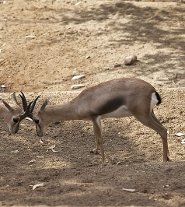
The
Speke's Gazelle (
Gazella spekei) is among the smallest of the Gazelles, reaching a length of 90.5 to 100.5 cm, equal to just over 3 feet, a height of about 50-60 cm, equal to 1.6 to 2 feet, and they weigh in at about 15 to 25 kg, or 33 to 55 pounds. The upper body is a brownish tan color, which is separated from the white belly by a black stripe. The unique folds on its nostrils inflate when excited, and are responsible for the loud resonant calls the Speke's Gazelle makes when threatened. Another unique behavior to the Speke's Gazelle is the blend of jumping, bouncing, and running they do when frightened.
The Speke's Gazelle has become endangered mainly because their grazing areas are often taken over by domestic livestock, and the range it covers has no protected areas so the threat of extinction will continue. The black stripes around the eyes reduce glare, and are bordered by white stripes, thus giving the animal a painted face appearance. Speke's Gazelles are found only on the horn of Africa, primarily in Somalia and some in neighboring Ethiopia. Like most animals living in a hot and dry scrubland environment, it is mostly active in the early morning and late evening hours, feeding on leaves, herbs and grass while resting during the day. The Speke's Gazelle can survive without water for some time, a useful adaptation in their harsh semi-desert environment.
Both male and female Speke's Gazelles have horns, males have longer curved horns while females have smaller straight horns. The Speke's Gazelle is on the menu of several predators including the Leopard, Hyena, Lion, Python, and
Cheetah, thus the young lie hidden and motionless in the brush until they are weaned at about three months. After a pregnancy of about 7 months, a single young is born among herds of about 12 to 20 animals, and Speke's Gazelles usually live about 12 years. Herds are composed of either a dominant male with his breeding harem covering an area of half to 2 square miles, or the bachelor herd of young and juvenile males.
Picture of the Speke's gazelle by Sanjay Acharya, licensed under the
Creative Commons Attribution-Share Alike 3.0 Unported license.
You can help spreading the word about this animal by liking it on facebook
Permanent Link
Thursday 14 October 2010
The European SeaBass - One of Europe's Most Important Fish
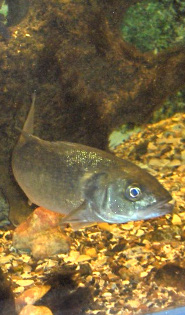
The
European SeaBass (
Dicentrarchus labrax) or Morone labrax or sea dace, is a popular eating fish throughout Europe. The European seabass lives primarily in the ocean however, it does occasionally make its way into fresh or brackish waters. Its popularity as a food fish has ensured that it has many ways throughout the different countries where it is consumed. In Spain, it is referred to as lubino or robalo. In Northern Italy it is called branzino, while other regions of Italy refer to it as spigola or ragno. Those who enjoy European seabass in Greece call it by a different name - lavraki. In English speaking areas, it is often referred to as Mediterranean seabass. No matter what it is called, this fish is a very popular eating fish that is consumed throughout Europe.
Adult European seabass have two dorsal fins, silver sides, and a white belly. Juvenile fish have black spots on the back and sides, which sometimes leads to confusion between this species and other related seabass. The operculum, or bony covering protecting the gills, is serrated and spined for protection. These fish reach an adult size of approximately 1 meter (3.3 feet) long and 15 kilograms (33.3 pounds) in weight. Mostly a night hunter, this fish feeds largely on cephalopods and crustaceans.
As noted above, European seabass is typically found in ocean waters, including the eastern Atlantic Ocean, the Mediterranean Sea, and the Black Sea. It is frequently found in lagoons, estuaries, coastal waters, and rivers throughout Europe.
Currently, the primary predator of European seabass is commercial fisherman. Due to its popularity among anglers, many countries have had to limit the amount of this fish caught and consumed. In the United Kingdom, major conservation efforts limit the size of
fish, the number that can be caught in a day, and the season in which fishing is allowed. Italians interested in protecting this species have undergone an intensive breeding program to increase numbers. Some recreational fishermen have created groups to help protect this species, as well.
In an attempt to increase production of this species without leading to its extinction, many countries in Europe have started farming fish. Farming seabass is popular throughout Spain, Croatia, Greece, and other European countries. The annual farming production of European seabass is 60,000 tons, which reflects how popular it is among consumers.
Picture of the european seabass licensed under
GFDL
You can help spreading the word about this animal by liking it on facebook
Permanent Link
Wednesday 13 October 2010
The Indian Flying Fox - The Little Fox That Is Really a Big Bat
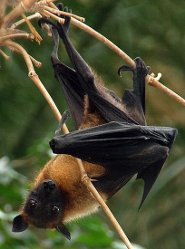
The
Indian flying fox (
Pteropus giganteus) looks a lot like a cute little red fox with wings. In fact, take away the leathery wings, and the fact that they sleep hanging upside down and it could be possible to forget that the Indian Flying Fox is really a bat. Their delicate, pointy ears, long, thin nose, lush red coat and soulful black eyes have a distinctive appeal that easily resembles the fox they are named after. It’s great size, relative to bats, also helps shape the features that make it more fox-like in appearance. The Indian flying fox has a broad wingspan of up to 130 cm (51.2 inches) from tip to tip and can weigh as much as 2 kilograms (4.4 pounds).
The Indian flying fox is native to the southern Asian continent, most notably in the countries of Bangladesh, China, Myanmar, Nepal, Bhutan, Maldives, Sri Lanka, Pakistan and, of course, India. While their numbers are on the downfall, they are still a common species in their native habitats.
The Indian flying fox spends its life in colonies numbering in the hundreds and even thousands. They prefer locations close to open fields, water sources or where there are a variety of flowers. These areas provide the best sources of their main food source which are fruits and berries. The sizes of the colonies are constantly fluctuating depending on the season. They are larger during rainy seasons that force the bats inside and keep them from spreading out in search of food, and smaller during hot, dry summer months. The Indian flying fox has a five month gestation period and spends an additional five to eight months with its mother. They are mature at two years of age when it becomes an adult member of the colony.
The Indian flying fox doesn’t have many natural enemies in the wild. Man is its greatest nemesis. It is a member of the fruit bat family, and often considered a nuisance, or vermin in their native land because of their widespread numbers and because deforestation has forced the flying mammals toward more urban roosting areas. The Indian flying fox is also hunted in countries such as Pakistan for its fat, thought to have medicinal qualities.
In spite of their great size, and the fact that bat folk-lore tends to make them fearsome creatures, the Indian flying fox is not the least bit dangerous. They do not feed on
humans and prefer to stay clear of them. However, they can cause great destruction to orchards and vineyards.
Picture of the Indian Flying Fox by Fritz Geller-Grimm, licensed under the
Creative Commons Attribution-Share Alike 2.5 Generic license.
You can help spreading the word about this animal by liking it on facebook
Permanent Link
Tuesday 12 October 2010
The Spinifex hopping mouse - A Determined Migrator
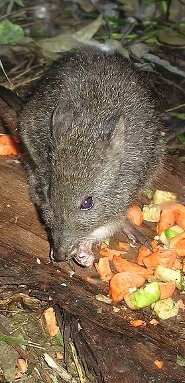
The
Spinifex hopping mouse (
Notomys alexis), which also goes by the name Tarkawara, is indigenous to western and central Australia. Their population is centered in arid regions such as the sand dunes, the spiniflex sand flats for which the animal is named, as well as melaleuca and mulga flats. They prefer dry environments and can migrate up to 15 kilometers during periods of intense rain.
The hopping mouse is similar in appearance to its relative, the Northern hopping mouse, and is slightly larger than the typical house mouse. It measures between 95 and 115 millimeters or 3.7 to 4.5 inches from head to the end of their body with the average weight being 35 grams or 1.2 ounces. The mouse has longer hind legs than the average mouse as well as shortened forelimbs with a longer than average tail, approximately 140 millimeters or 5.5 inches in length. Their fur is a fawn color with grey around the mouth as well as in the space between the ear and eye. Their hair is significantly courser and blacker on the back with the tail having very little fur.
The Spinifex hopping mouse lives in burrows which are typically located about 10 inches beneath the surface. The chamber in which the animals live is usually quite large and is lined with plant matter as well as small sticks. The mouse is largely nocturnal and leaves the den at night. They forage for food individually and eat a diet consisting primarily of seeds, green shoots, roots, as well as small invertebrates. They move with their body extended, almost completely horizontal, with their tail fully extended.
The Spinifex hopping mouse breeds primarily in the spring although they are able to do so throughout the year. The gestation period is quite short, approximately 40 days but can vary depending on whether or not the pregnant mouse is still nursing its previous litter. The litter can vary in size with the average being 3 babies. After the babies are born, they remain in the den when the family goes to forage for food. Sexual maturity is obtained without 2 ½ months.
The usual predators of the hopping mouse are owls, dingoes,
red foxes, and feral cats. The population can vary greatly with the population booming after rain and occasionally spreading out into different areas with the population decreasing during times of drought. Despite this, the species is currently not considered endangered.
You can help spreading the word about this animal by liking it on facebook
Permanent Link
Monday 11 October 2010
Antarctic fur seal - Nature's Deep Sea Diver
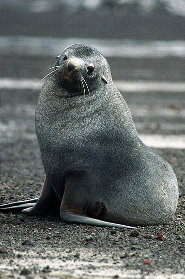
The
Antarctic fur seal (
Arctocephalus gazella), formerly called the Kerguelen fur seal, is an amazing animal that has been observed remaining underwater for up to ten minutes and diving to depths of two-hundred and fifty meters. However, most of the time the seals only stay under for two to three minutes and descend three or four meters.
The Antarctic fur seal's ability to prop itself up into a standing position upon its front flippers is one of its distinguishing characteristics. Most pups are born black in color, eventually turn silver-gray, and then gradually become brown as an adult. Some seals have lighter-colored fur. It has a lifespan of approximately 15 to 20 years. Adult females are approximately 1.2-1.4 meters (3.9-4.6 feet) in length and weigh 25-55 kilograms (55-121 pounds), adult males are approximately 1.6-2.0 meters (5.2-6.6 feet) in length and weigh 90-210 kilograms (198-463 pounds).
The Antarctic fur seal lives in the Antarctic Ocean, and comes ashore to reproduce. The seals reproduce on islands which are free of ice, located along the Antarctic Polar Front. The majority of the species reproduces along the coasts of the island of South Georgia. However, the species has a wide range and has been observed as far away as Brazil.
Male seals are approximately four times larger than the females, and are extremely territorial. The seals have a breeding season that runs from November to January. Each female has one pup per year.
Antarctic fur seals subsist primarily on a diet of krill, fish, and squid. They have been known to consume sea birds, and nursing females almost exclusively eat krill. Predators of Antarctic fur seals include
orcas,
leopard seals, and humans. The primary danger from people comes in the form of entanglement when man-made debris becomes wrapped around the neck of the seal, and it strangles or drowns.
In the early 1900s, the species was nearly extinct. There were only a few hundred Antarctic fur seals left due to massive over-hunting by people. Thanks to protective legislation, the population has rebounded, and by some estimates may have reached four or five million in the year 2000.
Antarctic fur seals are protected by the Convention for the Conservation of Antarctic Seals (CCAS), the Antarctic Treaty, and the national legislation of countries within its habitat. It is listed as an Appendix II species by the Convention on International Trade in Endangered Species of Wild Fauna and Flora (CITES).
Picture of the Antarctic fur seal by Jerzy Strzelecki, licensed under
GFDL
You can help spreading the word about this animal by liking it on facebook
Permanent Link
Friday 08 October 2010
Vulturine Guineafowl - Poor Flyers, Excellent Runners
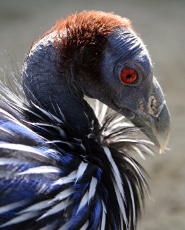
The
Vulturine Guinea fowl (
Acryllium vulturinum), also known as the Royal Guinea fowl, is the largest species of non-extinct guinea fowls. They range in length from 50.8 to 52.8 centimeters or 20 to 24 inches. In weight, they can vary although there is no data indicating what these ranges may be.
The animal is mostly found in areas of eastern Africa particularly in the tropical regions of Ethiopia, Tanzania, Uganda, Kenya, and Somalia. It is located primarily in areas of dry tall grass with sparse trees. The animals are primarily found in high areas as they prefer to roost out of reach of predators. The animals feed predominantly on seeds, tubers, roots, small reptiles, grubs, as well as small invertebrates, vegetables, and fruits. Their predators are mostly hawks and they escape these, unlike most birds, by running quite well through the brush.
The animal gets its name from its vulture like features, mainly its long neck and small head which are both devoid of feathers. The breast of the bird is a bright cobalt blue with the rest of the body being predominantly black and splattered with white. The females do not differ significantly in appearance from the males although they are typically somewhat smaller than their male counterparts. The
bird usually reaches sexual maturity at the age of 2 and has an average lifespan of 15 years. The vulturine guinea fowl (acryllium vulturinum) is currently not on the list of endangered species.
There are several unique characteristics of the vulturine guinea fowl including, for one, their ability to run at great avian speeds. In fact, they rarely have the need to fly except when flying to their nocturnal roosts. Another interesting aspect of the animal is that the sexes are practically indistinguishable from each other as they both have the same physical characteristics as well as coloring. The guinea fowl is also able to reproduce extensively with hens laying up to 40 eggs per season with the shells of the eggs being quite thick and difficult to damage. In some cases, multiple vulturine guinea fowl hens share the same roosting nest. When the birds are hatched from the eggs, they are almost fully developed and are able to fly within only a few days of birth. The animals tend to be very aggressive and will attack each other should they be competing for food or roost areas in trees.
Picture of the Vulturine Guineafowl, by Manfred Werner, licensed under
GFDL
You can help spreading the word about this animal by liking it on facebook
Permanent Link
Thursday 07 October 2010
The Rohu Fish - Nature's Sacred Delicacy
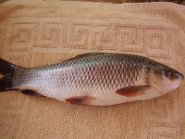
The
Rohu (Labeo rohita) is a freshwater fish of the carp family Cyprinidae that is also commonly called the Ruee, Rui or Tapra. Known to put up a strong and long fight when caught on a hook, this fish is considered to be a sacred delicacy to be eaten at all special occasions in some regions of India.
Rohu can be found throughout South Asia and South-East Asia in the weedy, slow flowing or standing waters of lakes and rivers. They have very few natural predators in these waters except when they are small fledglings. Before reaching a juvenile stage they are often consumed by turtles, water breathing insects and other types of larger fish.
The types of food this fish prefers to eat changes with age. In its early stages the diet consists mainly of zooplankton. As it grows it then prefers more phytoplankton and eventually feeds on phytoplankton and submerged plants as an adult. They also have a fondness for bread, which is the most common bait used for catching them on a hook.
Rohu are generally solitary and reach maturity between two and five years. Its spawning areas are most often in the shallow waters of flooded rivers. They are a colorful fish defined by an upper body of dark scales, a lower body and belly that is golden brown and fins that are bright red. One of their most defining features is a large, oval gaping mouth ringed by thick lips. They can live up to ten years in the wild, growing to a maximum length of 200 cm (78.74 inches) and a whopping 45 kgs (99.21 pounds) in weight. They are now widely cultured in ponds and on fish farms, but do not breed well in calm waters so induced spawning often becomes necessary.
The texture of the
fish is white, non-oily and the bigger the size of the fish the tastier it is. Rohu are heavily consumed throughout all areas in which they are found and prepared in a variety of ways. The roe is especially sought after as a delicacy and praised for its unique flavors. In many cases, the roe is also considered sacred and is most often fried and served hot as an appetizer at special ceremonies.
Picture of the Rohu by Khalid Mahmood, licensed under
GFDL.
You can help spreading the word about this animal by liking it on facebook
Permanent Link
Monday 04 October 2010
The Big-Eared, Bushy-Tailed Blandford's Fox
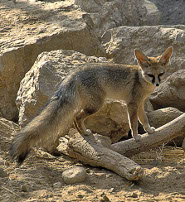
The
Blandford%u2019s fox (
Vulpes cana), is the second smallest of the fox-like canids. It weighs between 0.9-1.5 kg, or 1.98-3.31 lbs. The length of the head and body is about 42 cm, or 16.5 inches, and the tail length is between 28-30 cm, or 11-11.8 inches. The Blandford’s fox has a very bushy tail and large ears that overwhelm its slender body. The Vulpes cana has a cat-like appearance and demeanor. The muzzle is pointed and has a black stripe starting at the eye and reaching to the top lip. It has a soft coat of rusty brown, grey, and black. The throat and belly are creamy white. Its tail usually has a black tip, though sometimes it has a white one. A black band extends from the neck down the body and tail. The ears are dark brown. These foxes are considered rare, but because of their extreme habitat, not much is known of them. The IUCN classifies the Blandford’s fox as “Vulnerable” because of small population size and data deficiency. Its threats include disease, loss of habitat, and the
red fox.
Blandford’s foxes are monogamous. Males and females forage separately. Males and females use neighboring dens while raising young and separate dens for the rest of the year. Breeding can occur from January to February, but in captivity, it can occur until April. Gestation is 50-60 days, and litters include one to three pups. The pups feed only on milk until they are two months old, at which time they will begin accompanying their parents as they forage. At the age of four months, they begin to forage alone. Parents do not take food back into the den.
Blandford’s foxes spend a lot of time in dry riverbeds, where they feast on invertebrates, dead animals, birds, and tree fruit. They make their dens in natural caves and crevices, because they cannot dig their dens. Their life span is about four or five years. Death may come via old age or rabies, or they may fall prey to the red fox. It is possible that they are preyed upon as well by leopards, golden eagles, and eagle owls.
In Arabia, they are found only in the mountains of Saudi Arabia, Oman, Yemen, and United Arab Emirates. They will avoid areas where the red foxes reside. They are also found in the Middle East, Egypt, and throughout Western Asia.
Picture of the Blandford's Fox by Eyal Bartov, licensed under
GFDL
You can help spreading the word about this animal by liking it on facebook
Permanent Link
Saturday 02 October 2010
African Darter - The Riverside Snakebird
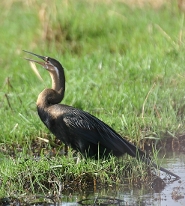
The
African Darter (
Anhinga rufa), also known as the Snakebird, is an animal unique to sub-Saharan Africa. It is known for its very long neck and its unique swimming style. The African Darter gets the nickname "Snakebird" because it swims similar to the way a snake slithers. Its head is above water while swimming, which is a different style from many birds worldwide. The African Darter is typically found in tropical wetlands, and they spend a lot of time sitting beside bodies of water, particularly in areas where mangroves are prominent. The African Darter is fond of shallow, still waters and usually swims with its head above water. Unlike many birds, the feathers of the African Darter are not waterproof, and the bird must dry its feathers before taking flight. For the most part, these birds lead a sedentary lifestyle. These birds are fairly large, with a body size reaching close to 80 centimeters and weight close to 1400 grams. In imperial units, this is equal to roughly 30 inches or three pounds.
African Darters typically live in groups of ten to fifty birds at a time, sometimes with colonies reaching one hundred birds in size. Breeding can be a seasonal affair, but birds can mate at any time during the year. The breeding grounds is normally on a nest platform constructed by the birds. The platforms can be found in trees or on islands near the water. Usually, birds lay nests of around three to six eggs at a time. After breeding, some birds may go through a flightless period of time, although this is not universal within the species.
Since the African Darter spends a lot of time in and around shallow bodies of water, its diet is composed primarily of amphibious animals. They mainly eat fish, frogs, crustaceans, or molluscs. These birds are able to eat fish and other foods from either saline or freshwater environments.
In some areas, the population of the African Darter has declined in recent years. This is due to pollution and destruction of the environment. It also has natural predators, including the
tawny eagle, the African fish-eagle, and the harrier-hawk. However, these threats are not so great that the species is becoming endangered. The African Darter population is very widespread and numerous, and for the moment it is not an endangered species.
Picture of the African darter by Susann Eurich in Chobe N.P. (Botswana), licensed under
GFDL
You can help spreading the word about this animal by liking it on facebook
Permanent Link
 The Soemmerring's Gazelle (Gazella soemmerringii) were once the most abundant Gazelle on the African continent, moving about in large herds of several hundred. Today, they can be found in small groups between 5 and 20, often intermingling with herds of hartebeest, oryx, and domesticated camels. Both CITES and IUCN have listed the Soemmerring's Gazelle as a vulnerable species due to a 30% decline over 3 generations (21 years). Current estimates are that the decline will continue at a rate of about 10% per year. The likeliest cause of the decline is the loss of habitat to domestic grazing, hunting, and regional political unrest.
The Soemmerring's Gazelle (Gazella soemmerringii) were once the most abundant Gazelle on the African continent, moving about in large herds of several hundred. Today, they can be found in small groups between 5 and 20, often intermingling with herds of hartebeest, oryx, and domesticated camels. Both CITES and IUCN have listed the Soemmerring's Gazelle as a vulnerable species due to a 30% decline over 3 generations (21 years). Current estimates are that the decline will continue at a rate of about 10% per year. The likeliest cause of the decline is the loss of habitat to domestic grazing, hunting, and regional political unrest.

 The
The  The
The  The
The  The
The  The
The  The
The  The
The  The
The  The
The  The
The  The
The